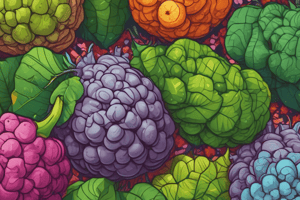Podcast
Questions and Answers
What is the primary objective of mixed cropping?
What is the primary objective of mixed cropping?
To maximize growing conditions and crop production, especially on a subsistence basis.
Describe the key difference between mixed crops and companion crops within a mixed cropping system.
Describe the key difference between mixed crops and companion crops within a mixed cropping system.
Mixed crops involve different crops mixed together, whereas companion crops are sown in distinct rows.
How do guard crops function in a mixed cropping system?
How do guard crops function in a mixed cropping system?
Guard crops protect the main crop by acting as a barrier against pests, rodents, or other threats.
What are the principles behind selecting crops for a mixed cropping system?
What are the principles behind selecting crops for a mixed cropping system?
What characterizes a 'mono' or sole cropping system?
What characterizes a 'mono' or sole cropping system?
What is the purpose of 'augmenting crops' in a mixed cropping system?
What is the purpose of 'augmenting crops' in a mixed cropping system?
What is one advantage of mixed cropping in an erratic environment?
What is one advantage of mixed cropping in an erratic environment?
What is the difference between a determinate and an indeterminate crop?
What is the difference between a determinate and an indeterminate crop?
What is a disadvantage of continuous cropping systems?
What is a disadvantage of continuous cropping systems?
What is the main objective of intercropping?
What is the main objective of intercropping?
Define parallel cropping as a subunit of intercropping.
Define parallel cropping as a subunit of intercropping.
What is the definition of a cropping system?
What is the definition of a cropping system?
What are two examples of advantages of companion cropping?
What are two examples of advantages of companion cropping?
How do farming systems differ from cropping systems?
How do farming systems differ from cropping systems?
Besides space utilization, what could be another benefit of intercropping?
Besides space utilization, what could be another benefit of intercropping?
Why might some cropping systems not be universally applicable?
Why might some cropping systems not be universally applicable?
What is Agroforestry?
What is Agroforestry?
What is a potential issue when using an intensive system such as intercropping?
What is a potential issue when using an intensive system such as intercropping?
Name three main cropping systems used in agriculture, as mentioned in the text?
Name three main cropping systems used in agriculture, as mentioned in the text?
What is the primary difference between mixed cropping and intercropping?
What is the primary difference between mixed cropping and intercropping?
Give one example of a specific crop pairing for intercropping.
Give one example of a specific crop pairing for intercropping.
What is the main objective of crop rotation?
What is the main objective of crop rotation?
List two factors that cause variability in cropping systems.
List two factors that cause variability in cropping systems.
What are three main things a cropping system includes or details?
What are three main things a cropping system includes or details?
Flashcards
Mixed Cropping
Mixed Cropping
Growing two or more annual crops together without a specific arrangement, often in an unpredictable environment.
Objective of Mixed Cropping
Objective of Mixed Cropping
The main goal is to maximize crop production, especially in environments with unstable conditions.
Companion Crops in Mixed Cropping
Companion Crops in Mixed Cropping
Different crops are sown in rows, but not in a random pattern.
Guard Crops in Mixed Cropping
Guard Crops in Mixed Cropping
Signup and view all the flashcards
Augmenting Crops in Mixed Cropping
Augmenting Crops in Mixed Cropping
Signup and view all the flashcards
Legumes with Non-Legumes in Mixed Cropping
Legumes with Non-Legumes in Mixed Cropping
Signup and view all the flashcards
Tall & Short Crops in Mixed Cropping
Tall & Short Crops in Mixed Cropping
Signup and view all the flashcards
Determinate & Indeterminate Crops in Mixed Cropping
Determinate & Indeterminate Crops in Mixed Cropping
Signup and view all the flashcards
Cropping System
Cropping System
Signup and view all the flashcards
Farming System
Farming System
Signup and view all the flashcards
Agroforestry System
Agroforestry System
Signup and view all the flashcards
Intercropping
Intercropping
Signup and view all the flashcards
Crop Rotation
Crop Rotation
Signup and view all the flashcards
Factors Affecting Cropping Systems
Factors Affecting Cropping Systems
Signup and view all the flashcards
Merits of a Cropping System
Merits of a Cropping System
Signup and view all the flashcards
Parallel cropping
Parallel cropping
Signup and view all the flashcards
Subsidary Crop
Subsidary Crop
Signup and view all the flashcards
Continuous Cropping
Continuous Cropping
Signup and view all the flashcards
Maximize Space Utilization
Maximize Space Utilization
Signup and view all the flashcards
Benefits of Intercropping
Benefits of Intercropping
Signup and view all the flashcards
Technical Expertise Required
Technical Expertise Required
Signup and view all the flashcards
Intercropping Applicability
Intercropping Applicability
Signup and view all the flashcards
Study Notes
Cropping Systems
- Cropping systems describe how crops are grown over time in a specific area. It includes the resources used for this activity.
- It encompasses all cropping patterns, along with their interactions with farm resources and factors like technology, environment and social factors.
- Objectives of study include distinguishing types of cropping systems (e.g., cropping, farming, agroforestry).
- Identifying the importance of each system by understanding its guiding principles is also an objective. Another objective is assessing the merits and downsides of each system.
Other Production Systems
- Farming systems include all parts of a farm: livestock, household, cropping patterns, and production methods.
- Agroforestry involves strategically planting trees with other crops or animals for increased benefits to land users and to the environment.
Cropping Systems Continued
- Cropping systems vary. Crops can be planted together at the same time, or sequentially (one after another), or separately, and in short intervals on the same land area.
- There are five main cropping systems used in agriculture.
Mixed Cropping System
- This involves growing two or more crops together on the same piece of land without specific arrangement.
- This system is useful in unstable environments.
- Crops can be planted at the same or different times of the same season, either in rows or broadcast.
Mixed Cropping System Continued
-
The objective is to maximize growing conditions and produce crops, especially for subsistence farming.
-
Mixed cropping has various forms: mixed crops (growing different crops together in rows or broadcast), companion crops (growing different crops in separate rows), guard crops (surrounding the main crop to protect it from pests or as deterrents), and augmenting crops (supplementing the main crop's yield).
Mixed Cropping System Continued (Advantages)
- Prevents total crop failure during unfavorable conditions (pest attacks, disease, fire).
- Low labor cost.
- Helps maintain soil fertility
- Provides farmers with enough produce for their daily needs.
- Simple management.
Mixed Cropping System Continued (Disadvantages)
- Non-scientific approach.
- Difficult to carry out all agricultural practices as needed.
- Difficult to calculate the total planting population
- Not using mechanization to planting.
- Incorrect planting distances which would optimize yield
Multiple Cropping System
-
This involves growing two or more crops in a single year.
-
Considered an intense cropping system allowing multiple crops on the same land.
-
Has two subgroups:
- Relay cropping: Growing two crops sequentially. One crop starts before the other and is harvested before the other is fully grown.
- Overlapping cropping: Growing two crops together for a period longer than relay cropping.
Multiple Cropping System (Objectives)
- Increase income from a land area within a particular time period.
- For commercial gain, not subsistence farming.
Multiple Cropping System (Principles)
- Employ high-yielding, short-duration crops.
- Crops must respond favorably to agricultural inputs.
Multiple Cropping/Disadvantages
- Requires significant technical proficiency.
- May be susceptible to disease and pests.
- Potentially high initial costs
Intercropping System
- An intensive system where a supplementary crop is grown alongside a main crop in rows.
- The objective is to use the space between main crop rows to maximize yield per unit area.
- Types include parallel cropping (planting crops in parallel rows), and companion cropping (planting crops alongside each other).
Intercropping (Principles)
- Crops should complement each other (not compete).
- Subsidiary crops grow quickly, so they use the available light and nutrients available in the early stages of the main crop's growth
- Similar agricultural practices are preferred for both plants.
Intercropping (Advantages)
- Increased nutrient utilization from different soil depths.
- Higher biomass production per area, and often per time.
- Greater overall yields.
- Improved crop quality and quantity
Intercropping (Disadvantages)
- Potential competition.
- Not suitable for all land types or situations.
- Requires extra labor in some cases.
Crop Rotation System
- Crop rotation involves planting different crops in a planned sequence on the same land over multiple years.
- The objective is to ensure that the land is used efficiently while also maintaining soil fertility.
- Principles often highlight the importance of planting different types of crops and avoiding planting crops from the same family, in successions. Plants that exhaust the nutrients in soil, should precede plants that do not exhaust the nutrients.
Crop Rotation System (Advantages)
- Efficient land use.
- Checks soil erosion.
- Breaks pests and disease cycles.
Crop Rotation System (Disadvantages)
- Needs sound knowledge of plant physiology and agronomy.
- Some crop rotations are less suitable to larger-scale operations
- It may be more challenging on smaller plots
Mono-cropping System
- Growing a single type of crop consistently on the same land over an extended period, as opposed to rotating crops.
- The objective is to grow large quantities of a single crop type, either annually or perennially.
Mono-cropping System (Advantages)
- Allows for crop specialization on a large scale
- Facilitates mechanization and standardization.
- Easier to manage specific cultural practices for the selected crop type.
Mono-cropping System (Disadvantages)
- Increased risk of pests and diseases.
- Potentially depleted nutrients and soil degradation.
- Vulnerable to total crop failure if conditions become unfavorable, due to monoculture.
Assessments of Cropping Systems
- The assessment of cropping systems helps in understanding how the yield is developed as a function of the land use.
- Metrics include cropping intensity index, land equivalent ratio, and relative crowding coefficient.
Studying That Suits You
Use AI to generate personalized quizzes and flashcards to suit your learning preferences.





